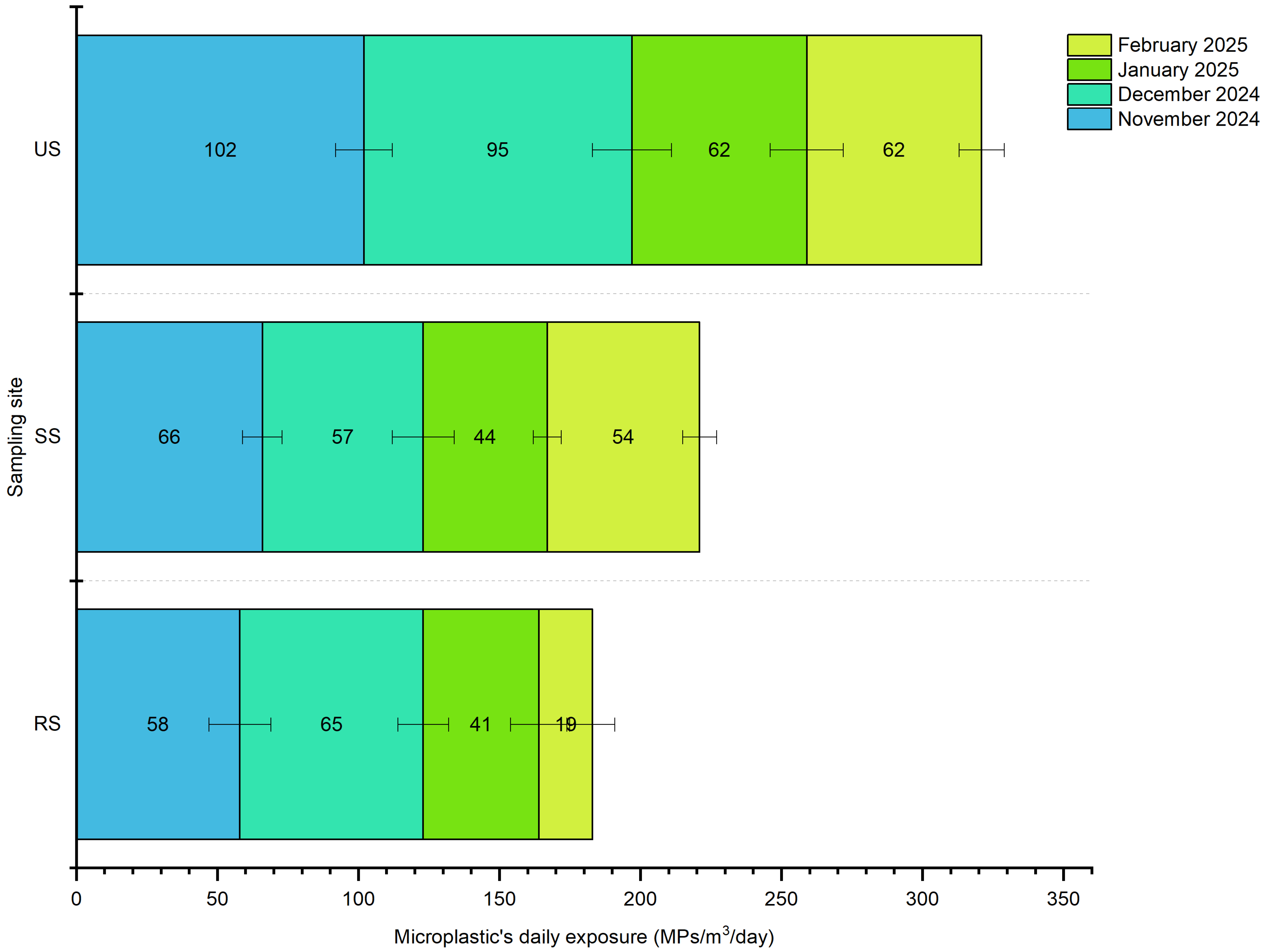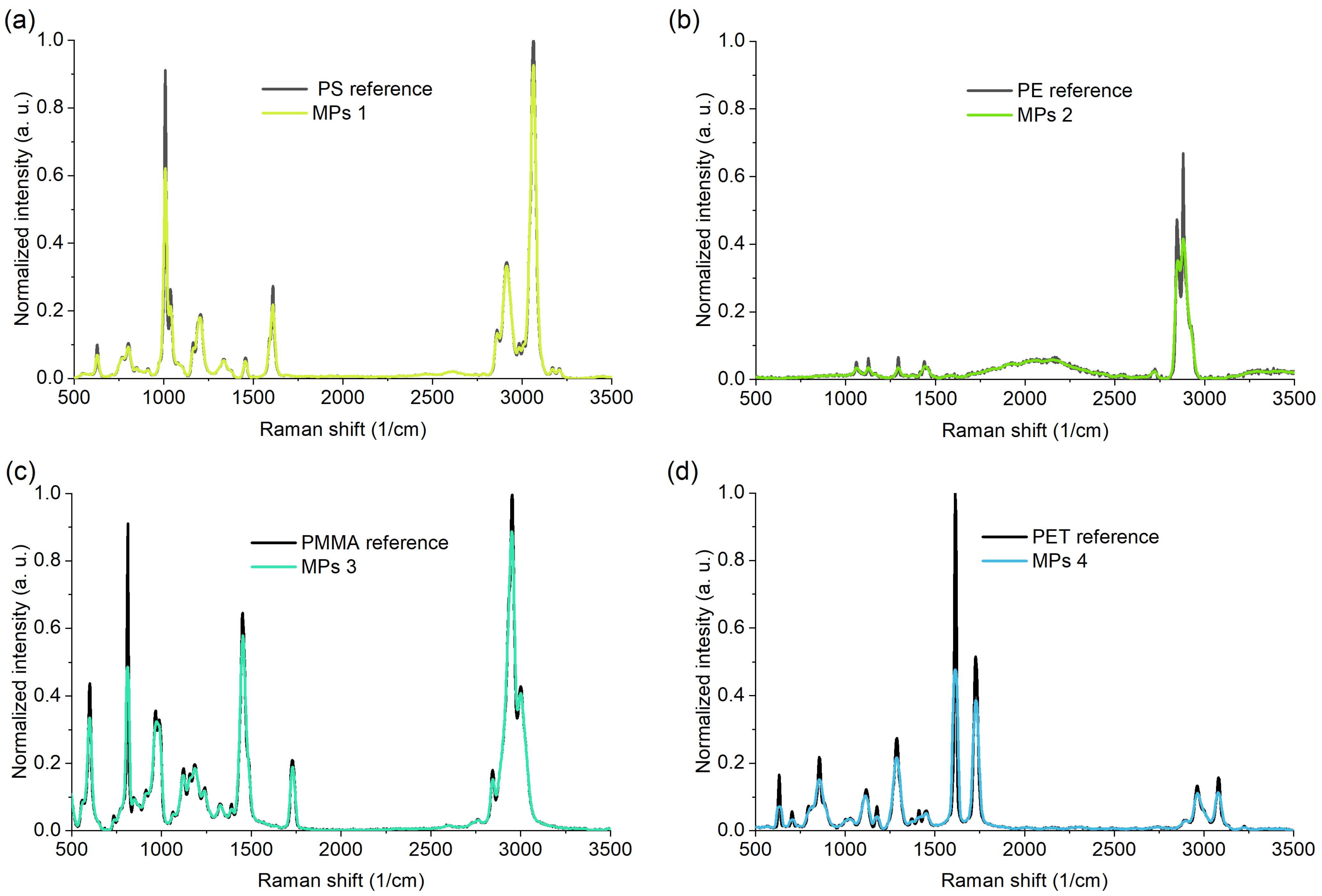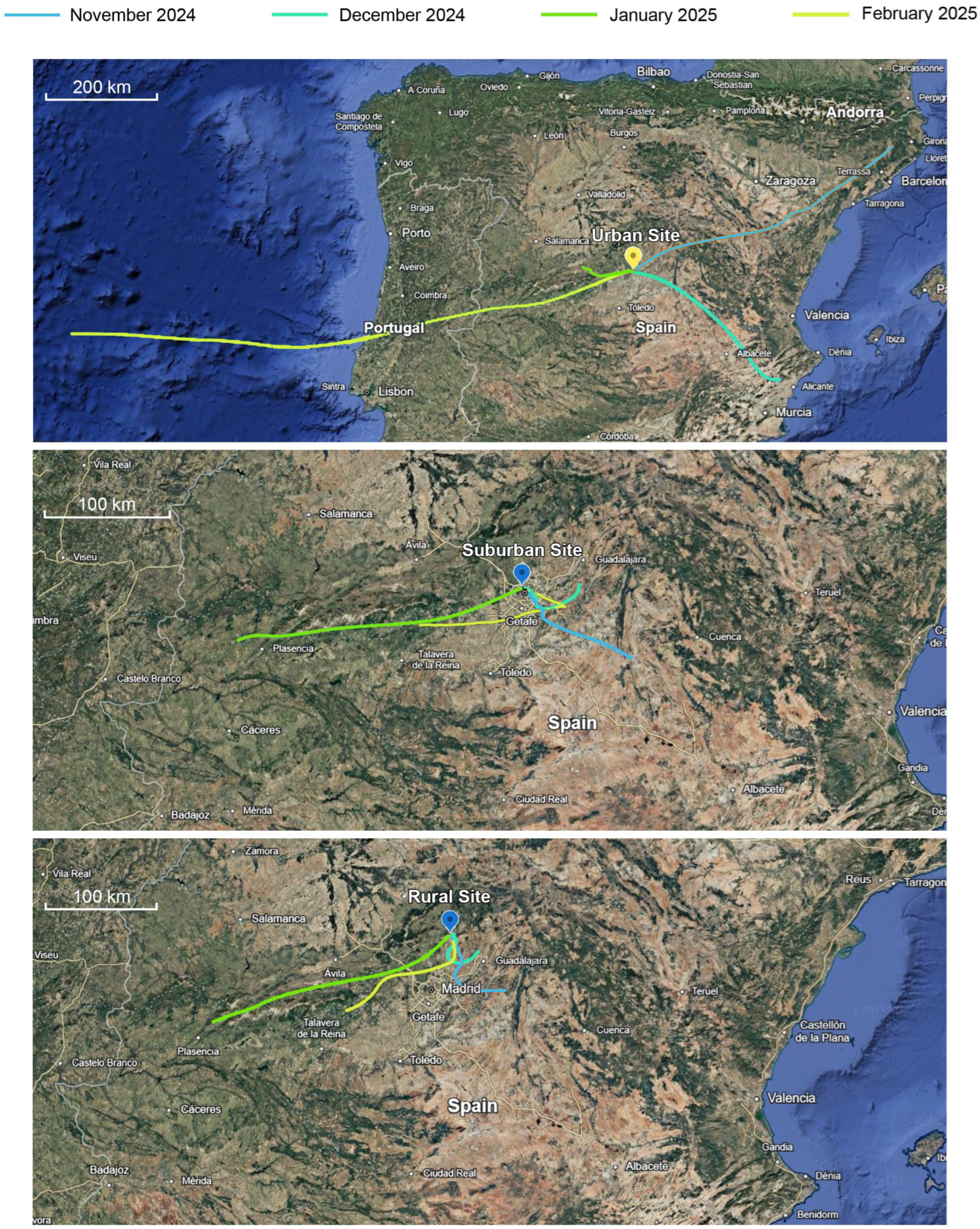An Overview of Microplastic Exposure in Urban, Suburban, and Rural Aerosols
Abstract
1. Introduction
2. Materials and Methods
2.1. Geographical Context of the Study and Aerosol Sampling Protocol
2.2. Methodology for Direct Counting of Microplastics in the Filter
2.3. Microplastic’s Identification
2.4. Estimation of Potential Sources of Atmospheric Microplastics
2.5. Quality Assurance and Quality Control (QA/QC) Methodological Approach
3. Results and Discussion
3.1. Atmospheric MPs Exposure
3.2. MPs Polymer Identity
3.3. MPs Backtrajectories and Potential Sources and Transport
4. Conclusions
Author Contributions
Funding
Data Availability Statement
Conflicts of Interest
Correction Statement
References
- Ragusa, A.; Svelato, A.; Santacroce, C.; Catalano, P.; Notarstefano, V.; Carnevali, O.; Papa, F.; Rongioletti, M.C.A.; Baiocco, F.; Draghi, S.; et al. Plasticenta: First evidence of microplastics in human placenta. Environ. Int. 2021, 146, 106274. [Google Scholar] [CrossRef]
- Nihart, A.J.; Garcia, M.A.; El Hayek, E.; Liu, R.; Olewine, M.; Kingston, J.D.; Castillo, E.F.; Gullapalli, R.R.; Howard, T.; Bleske, B.; et al. Bioaccumulation of microplastics in decedent human brains. Nat. Med. 2025, 31, 1114–1119. [Google Scholar] [CrossRef] [PubMed]
- Al Mamun, A.; Prasetya, T.A.E.; Dewi, I.R.; Ahmad, M. Microplastics in human food chains: Food becoming a threat to health safety. Sci. Total Environ. 2023, 858, 159834. [Google Scholar] [CrossRef]
- Eze, C.G.; Nwankwo, C.E.; Dey, S.; Sundaramurthy, S.; Okeke, E.S. Food chain microplastics contamination and impact on human health: A review. Environ. Chem. Lett. 2024, 22, 1889–1927. [Google Scholar] [CrossRef]
- Smith, M.; Love, D.C.; Rochman, C.M.; Neff, R.A. Microplastics in Seafood and the Implications for Human Health. Curr. Environ. Health Rep. 2018, 5, 375–386. [Google Scholar] [CrossRef]
- Leslie, H.A.; van Velzen, M.J.; Brandsma, S.H.; Vethaak, A.D.; Garcia-Vallejo, J.J.; Lamoree, M.H. Discovery and quantification of plastic particle pollution in human blood. Environ. Int. 2022, 163, 107199. [Google Scholar] [CrossRef]
- Cox, K.D.; Covernton, G.A.; Davies, H.L.; Dower, J.F.; Juanes, F.; Dudas, S.E. Human Consumption of Microplastics. Environ. Sci. Technol. 2019, 53, 7068–7074. [Google Scholar] [CrossRef]
- Chen, G.; Fu, Z.; Yang, H.; Wang, J. An overview of analytical methods for detecting microplastics in the atmosphere. TrAC Trends Anal. Chem. 2020, 130, 115981. [Google Scholar] [CrossRef]
- Seo, J.H.; Shin, Y.; Song, I.-G.; Lim, J.; Ok, Y.S.; Weon, S. Atmospheric microplastics: Challenges in site- and target-specific measurements. TrAC Trends Anal. Chem. 2024, 178, 117859. [Google Scholar] [CrossRef]
- Cárdenas-Escudero, J.; Deylami, S.; Ochoa, M.L.; Ruiz, J.U.; Galán-Madruga, D.; Cáceres, J. Elucidating microplastic’s seasonal occurrence in urban indoor and outdoor aerosol. Sci. Total. Environ. 2025, 991, 179896. [Google Scholar] [CrossRef]
- Amato-Lourenço, L.F.; Carvalho-Oliveira, R.; Júnior, G.R.; Galvão, L.d.S.; Ando, R.A.; Mauad, T. Presence of airborne microplastics in human lung tissue. J. Hazard. Mater. 2021, 416, 126124. [Google Scholar] [CrossRef] [PubMed]
- Eberhard, T.; Casillas, G.; Zarus, G.M.; Barr, D.B. Systematic review of microplastics and nanoplastics in indoor and outdoor air: Identifying a framework and data needs for quantifying human inhalation exposures. J. Expo. Sci. Environ. Epidemiol. 2024, 34, 185–196. [Google Scholar] [CrossRef]
- Lopez, A.P.A.; Trilleras, J.; Arana, V.A.; Garcia-Alzate, L.S.; Grande-Tovar, C.D. Atmospheric microplastics: Exposure, toxicity, and detrimental health effects. RSC Adv. 2023, 13, 7468–7489. [Google Scholar] [CrossRef]
- Ageel, H.K.; Harrad, S.; Abdallah, M.A.-E. Microplastics in indoor air from Birmingham, UK: Implications for inhalation exposure. Environ. Pollut. 2024, 362, 124960. [Google Scholar] [CrossRef]
- Borgatta, M.; Breider, F. Inhalation of Microplastics—A Toxicological Complexity. Toxics 2024, 12, 358. [Google Scholar] [CrossRef]
- Baeza-Martínez, C.; Olmos, S.; González-Pleiter, M.; López-Castellanos, J.; García-Pachón, E.; Masiá-Canuto, M.; Hernández-Blasco, L.; Bayo, J. First evidence of microplastics isolated in European citizens’ lower airway. J. Hazard. Mater. 2022, 438, 129439. [Google Scholar] [CrossRef]
- Marina-Montes, C.; Motto-Ros, V.; Pérez-Arribas, L.V.; Anzano, J.; Millán-Martínez, M.; Cáceres, J.O. Aerosol analysis by micro laser-induced breakdown spectroscopy: A new protocol for particulate matter characterization in filters. Anal. Chim. Acta 2021, 1181, 338947. [Google Scholar] [CrossRef]
- Gratzl, J.; Seifried, T.M.; Stolzenburg, D.; Grothe, H. A fluorescence approach for an online measurement technique of atmospheric microplastics. Environ. Sci. Atmos. 2024, 4, 601–610. [Google Scholar] [CrossRef] [PubMed]
- Vasudeva, M.; Warrier, A.K.; Kartha, V.; Unnikrishnan, V. Advances in microplastic characterization: Spectroscopic techniques and heavy metal adsorption insights. TrAC Trends Anal. Chem. 2025, 183, 118111. [Google Scholar] [CrossRef]
- Rahman, L.; Mallach, G.; Kulka, R.; Halappanavar, S. Microplastics and nanoplastics science: Collecting and characterizing airborne microplastics in fine particulate matter. Nanotoxicology 2021, 15, 1253–1278. [Google Scholar] [CrossRef] [PubMed]
- Klein, M.; Bechtel, B.; Brecht, T.; Fischer, E.K. Spatial distribution of atmospheric microplastics in bulk-deposition of urban and rural environments—A one-year follow-up study in northern Germany. Sci. Total. Environ. 2023, 901, 165923. [Google Scholar] [CrossRef] [PubMed]
- Mutshekwa, T.; Mulaudzi, F.; Maiyana, V.P.; Mofu, L.; Munyai, L.F.; Murungweni, F.M.; VishnuRadhan, R. Atmospheric deposition of microplastics in urban, rural, forest environments: A case study of Thulamela Local Municipality. PLoS ONE 2025, 20, e0313840. [Google Scholar] [CrossRef]
- Parashar, N.; Hait, S. Plastic rain—Atmospheric microplastics deposition in urban and peri-urban areas of Patna City, Bihar, India: Distribution, characteristics, transport, and source analysis. J. Hazard. Mater. 2023, 458, 131883. [Google Scholar] [CrossRef]
- Lu, L.; Zhang, R.; Wang, K.; Tian, J.; Wu, Q.; Xu, L. Occurrence, influencing factors and sources of atmospheric microplastics in peri-urban farmland ecosystems of Beijing, China. Sci. Total. Environ. 2024, 912, 168834. [Google Scholar] [CrossRef] [PubMed]
- Chen, Y.; Meng, Y.; Liu, G.; Huang, X.; Chai, G.; Xie, Y. Atmospheric deposition of microplastics at a western China metropolis: Relationship with underlying surface types and human exposure. Environ. Pollut. 2024, 355, 124192. [Google Scholar] [CrossRef]
- Du, R.; Lin, H.; Sun, J.; Zhang, J.; Luo, J.; Huang, X.; Pan, Z. Unveiling the suspended atmospheric microplastic pollution in a coastal urban landscape. J. Clean. Prod. 2024, 442, 141145. [Google Scholar] [CrossRef]
- Luo, D.; Wang, Z.; Liao, Z.; Chen, G.; Ji, X.; Sang, Y.; Qu, L.; Chen, Z.; Wang, Z.; Dahlgren, R.A.; et al. Airborne microplastics in urban, rural and wildland environments on the Tibetan Plateau. J. Hazard. Mater. 2023, 465, 133177. [Google Scholar] [CrossRef]
- Kernchen, S.; Löder, M.G.; Fischer, F.; Fischer, D.; Moses, S.R.; Georgi, C.; Nölscher, A.C.; Held, A.; Laforsch, C. Airborne microplastic concentrations and deposition across the Weser River catchment. Sci. Total. Environ. 2022, 818, 151812. [Google Scholar] [CrossRef]
- Chang, D.Y.; Jeong, S.; Shin, J.; Park, J.; Park, C.R.; Choi, S.; Chun, C.-H.; Chae, M.-Y.; Lim, B.C. First quantification and chemical characterization of atmospheric microplastics observed in Seoul, South Korea. Environ. Pollut. 2023, 327, 121481. [Google Scholar] [CrossRef] [PubMed]
- Yoo, H.; Kim, M.; Lee, Y.; Park, J.; Lee, H.; Song, Y.-C.; Ro, C.-U. Novel Single-Particle Analytical Technique for Inhalable Airborne Microplastic Particles by the Combined Use of Fluorescence Microscopy, Raman Microspectrometry, and SEM/EDX. Anal. Chem. 2023, 95, 8552–8559. [Google Scholar] [CrossRef]
- Jiang, J.; Ren, H.; Wang, X.; Liu, B. Pollution characteristics and potential health effects of airborne microplastics and culturable microorganisms during urban haze in Harbin, China. Bioresour. Technol. 2024, 393, 130132. [Google Scholar] [CrossRef]
- Corell, D.; Estrela, M.J.; Valiente, J.A. Seasonal behaviour and influence of altitude on fog-water collection in the Eastern Iberian Peninsula (2003–2012). Int. J. Clim. 2023, 43, 1935–1954. [Google Scholar] [CrossRef]
- Bugnard, A.; Coen, M.C.; Hervo, M.; Leuenberger, D.; Arpagaus, M.; Monhart, S. Comparison of temperature and wind profiles between ground-based remote sensing observations and numerical weather prediction model in complex Alpine topography: The Meiringen campaign. Atmos. Meas. Tech. 2025, 18, 1039–1061. [Google Scholar] [CrossRef]
- Houchi, K.; Stoffelen, A.; Marseille, G.J.; De Kloe, J. Comparison of wind and wind shear climatologies derived from high-resolution radiosondes and the ECMWF model. J. Geophys. Res. Atmos. 2010, 115, D22. [Google Scholar] [CrossRef]
- Kuroda, M.; Isobe, A.; Uchida, K.; Tokai, T.; Kitakado, T.; Yoshitake, M.; Miyamoto, Y.; Mukai, T.; Imai, K.; Shimizu, K.; et al. Abundance and potential sources of floating polystyrene foam macro- and microplastics around Japan. Sci. Total. Environ. 2024, 925, 171421. [Google Scholar] [CrossRef]
- Kik, K.; Bukowska, B.; Sicińska, P. Polystyrene nanoparticles: Sources, occurrence in the environment, distribution in tissues, accumulation and toxicity to various organisms. Environ. Pollut. 2020, 262, 114297. [Google Scholar] [CrossRef]
- An, L.; Liu, Q.; Deng, Y.; Wu, W.; Gao, Y.; Ling, W. Sources of Microplastic in the Environment. In Microplastics in Terrestrial Environments: Emerging Contaminants and Major Challenges; He, D., Luo, Y., Eds.; Springer International Publishing: Cham, Switzerland, 2020; pp. 143–159. [Google Scholar]
- Gao, S.; Orlowski, N.; Bopf, F.K.; Breuer, L. A review on microplastics in major European rivers. WIREs Water 2024, 11, e1713. [Google Scholar] [CrossRef]
- Mani, T.; Burkhardt-Holm, P. Seasonal microplastics variation in nival and pluvial stretches of the Rhine River—From the Swiss catchment towards the North Sea. Sci. Total. Environ. 2020, 707, 135579. [Google Scholar] [CrossRef] [PubMed]
- Klein, S.; Worch, E.; Knepper, T. Microplastics in the Rhine-Main area in Germany: Occurrence, spatial distribution and sorption of organic contaminants. Environ. Sci. Technol. 2015, 49, 2–3. [Google Scholar] [CrossRef] [PubMed]
- Mehmood, T.; Peng, L. Polyethylene scaffold net and synthetic grass fragmentation: A source of microplastics in the atmosphere? J. Hazard. Mater. 2022, 429, 128391. [Google Scholar] [CrossRef]
- Qiang, L.; Hu, H.; Li, G.; Xu, J.; Cheng, J.; Wang, J.; Zhang, R. Plastic mulching, and occurrence, incorporation, degradation, and impacts of polyethylene microplastics in agroecosystems. Ecotoxicol. Environ. Saf. 2023, 263, 115274. [Google Scholar] [CrossRef] [PubMed]
- Kitahara, K.-I.; Nakata, H. Plastic additives as tracers of microplastic sources in Japanese road dusts. Sci. Total. Environ. 2020, 736, 139694. [Google Scholar] [CrossRef] [PubMed]
- Mandal, M.; Roy, A.; Singh, P.; Sarkar, A. Quantification and characterization of airborne microplastics and their possible hazards: A case study from an urban sprawl in eastern India. Front. Environ. Chem. 2024, 5, 1499873. [Google Scholar] [CrossRef]
- Mani, T.; Primpke, S.; Lorenz, C.; Gerdts, G.; Burkhardt-Holm, P. Microplastic Pollution in Benthic Midstream Sediments of the Rhine River. Environ. Sci. Technol. 2019, 53, 6053–6062. [Google Scholar] [CrossRef] [PubMed]
- Osman, A.I.; Hosny, M.; Eltaweil, A.S.; Omar, S.; Elgarahy, A.M.; Farghali, M.; Akinyede, K.A. Microplastic sources, formation, toxicity and remediation: A review. Environ. Chem. Lett. 2023, 21, 2129–2169. [Google Scholar] [CrossRef]
- Alay Aksoy, S.; Alkan, C.; Tözüm, M.S.; Demirbağ, S.; Altun Anayurt, R.; Ulcay, Y. Preparation and textile application of poly(methyl methacrylate-co-methacrylic acid)/n-octadecane and n-eicosane microcapsules. J. Text. Inst. 2017, 108, 30–41. [Google Scholar] [CrossRef]
- Schrank, I.; Löder, M.G.J.; Imhof, H.K.; Moses, S.R.; Heß, M.; Schwaiger, J.; Laforsch, C. Riverine microplastic contamination in southwest Germany: A large-scale survey. Front. Earth Sci. 2022, 10, 794250. [Google Scholar] [CrossRef]
- Chen, G.; Feng, Q.; Wang, J. Mini-review of microplastics in the atmosphere and their risks to humans. Sci. Total. Environ. 2020, 703, 135504. [Google Scholar] [CrossRef]
- Can-Güven, E. Microplastics as emerging atmospheric pollutants: A review and bibliometric analysis. Air Qual. Atmosphere Health 2020, 14, 203–215. [Google Scholar] [CrossRef]
- Huang, Y.; He, T.; Yan, M.; Yang, L.; Gong, H.; Wang, W.; Qing, X.; Wang, J. Atmospheric transport and deposition of microplastics in a subtropical urban environment. J. Hazard. Mater. 2021, 416, 126168. [Google Scholar] [CrossRef]
- Tanjil, R.H.; Islam, S.; Islam, Z.; Roy, S.; Nahian, S.; Salam, A. Atmospheric Microplastic Pollution in Textile Industrial Areas: Source, Composition, and Health Risk Assessment. Bull. Environ. Contam. Toxicol. 2025, 114, 51. [Google Scholar] [CrossRef] [PubMed]
- O’BRien, S.; Rauert, C.; Ribeiro, F.; Okoffo, E.D.; Burrows, S.D.; O’BRien, J.W.; Wang, X.; Wright, S.L.; Thomas, K.V. There’s something in the air: A review of sources, prevalence and behaviour of microplastics in the atmosphere. Sci. Total. Environ. 2023, 874, 162193. [Google Scholar] [CrossRef] [PubMed]
- Corcoran, P.L. Degradation of Microplastics in the Environment. In Handbook of Microplastics in the Environment; Rocha-Santos, T., Costa, M.F., Mouneyrac, C., Eds.; Springer International Publishing: Cham, Switzerland, 2022; pp. 531–542. [Google Scholar]
- Thakur, B.; Singh, J.; Singh, J.; Angmo, D.; Vig, A.P. Biodegradation of different types of microplastics: Molecular mechanism and degradation efficiency. Sci. Total. Environ. 2023, 877, 162912. [Google Scholar] [CrossRef]
- Cai, Z.; Li, M.; Zhu, Z.; Wang, X.; Huang, Y.; Li, T.; Gong, H.; Yan, M. Biological Degradation of Plastics and Microplastics: A Recent Perspective on Associated Mechanisms and Influencing Factors. Microorganisms 2023, 11, 1661. [Google Scholar] [CrossRef] [PubMed]
- Petersen, F.; Hubbart, J.A. The occurrence and transport of microplastics: The state of the science. Sci. Total. Environ. 2021, 758, 143936. [Google Scholar] [CrossRef] [PubMed]
- Su, L.; Xiong, X.; Zhang, Y.; Wu, C.; Xu, X.; Sun, C.; Shi, H. Global transportation of plastics and microplastics: A critical review of pathways and influences. Sci. Total. Environ. 2022, 831, 154884. [Google Scholar] [CrossRef]




| City | MPs Concentration Reported a | Site | MPs Collection Method | Reference |
|---|---|---|---|---|
| Hamburg (Germany) | 89 ± 61 MPs·m−2 | Urban | Passive | [21] |
| Bremerhaven (Germany) | 91 ± 47 MPs·m−3·day−1 | Urban | Active | [28] |
| Thulamela (South Africa) | 212 ± 32 MPs·m−2 | Urban | Passive | [22] |
| Patna (India) | 1960 ± 205 MPs·m−2 | Urban | Passive | [23] |
| 1321 ± 126 MPs·m−2 | Suburban | |||
| Seoul (South Korea) | 144 ± 2 MPs·m−3·day−1 | Urban | Active | [29] |
| Incheon (Korea) | 192 ± 127 MPs·m−3·day−1 | Urban | Active | [30] |
| Harbin (China) | 163 ± 45 MPs·m−3·day−1 | Urban | Active | [31] |
| 64 ± 22 MPs·m−3·day−1 | Suburban | |||
| 13 ± 6 MPs·m−3·day−1 | Rural | |||
| Madrid (Spain) | 80 ± 21 MPs·m−3·day−1 | Urban | Active | This study |
| 55 ± 9 MPs·m−3·day−1 | Suburban | |||
| 46 ± 20 MPs·m−3·day−1 | Rural |
| Polymer | Formulae | Potential Sources | References |
|---|---|---|---|
| Polystyrene (PS) | (C8H8)ₙ | Aquaculture buoys | [35] |
| Compact discs (CDs), toys, toothbrushes, etc. | [36] | ||
| Personal care products, cosmetics, disposable plastic tableware, and fishing waste | [37] | ||
| Aggregates, pellets, pre-production materials | [38] | ||
| ion exchange resins for water softening and various industrial wastewater purification processes) | [39] | ||
| Pharmaceuticals | [40] | ||
| Synthetic textiles | [39] | ||
| Polyethylene (PE) | (C2H4)ₙ | Personal care products, washing wastewaters, and farming films | [37] |
| Synthetic grass and scaffold nets | [41] | ||
| Plastic mulching, mulch film on agricultural land | [42] | ||
| Road dusts | [43] | ||
| Pharmaceuticals | [39] | ||
| Synthetic textiles | [39] | ||
| Polymethyl methacrylate (PMMA) | (C5O2H8)n | Personal care products | [37] |
| Road dusts | [43] | ||
| Aggregates, pellets, pre-production materials | [38,44] | ||
| Antifouling ship paint and varnishes | [45,46] | ||
| Synthetic textiles and textile softener | [47] | ||
| Polyethylene terephthalate (PET) | (C10H8O4)n | Personal care products and sewage sludge | [37] |
| Road dusts | [43] | ||
| Synthetic textiles | [48] | ||
| Shopping bags and packaging sacks | [48] |
Disclaimer/Publisher’s Note: The statements, opinions and data contained in all publications are solely those of the individual author(s) and contributor(s) and not of MDPI and/or the editor(s). MDPI and/or the editor(s) disclaim responsibility for any injury to people or property resulting from any ideas, methods, instructions or products referred to in the content. |
© 2025 by the authors. Licensee MDPI, Basel, Switzerland. This article is an open access article distributed under the terms and conditions of the Creative Commons Attribution (CC BY) license (https://creativecommons.org/licenses/by/4.0/).
Share and Cite
Cárdenas-Escudero, J.; Deylami, S.; Ochoa, M.L.; Cañamero, P.; Ruiz, J.U.; Galán-Madruga, D.; Cáceres, J.O. An Overview of Microplastic Exposure in Urban, Suburban, and Rural Aerosols. Appl. Sci. 2025, 15, 8967. https://doi.org/10.3390/app15168967
Cárdenas-Escudero J, Deylami S, Ochoa ML, Cañamero P, Ruiz JU, Galán-Madruga D, Cáceres JO. An Overview of Microplastic Exposure in Urban, Suburban, and Rural Aerosols. Applied Sciences. 2025; 15(16):8967. https://doi.org/10.3390/app15168967
Chicago/Turabian StyleCárdenas-Escudero, J., S. Deylami, M. López Ochoa, P. Cañamero, J. Urraca Ruiz, D. Galán-Madruga, and J. O. Cáceres. 2025. "An Overview of Microplastic Exposure in Urban, Suburban, and Rural Aerosols" Applied Sciences 15, no. 16: 8967. https://doi.org/10.3390/app15168967
APA StyleCárdenas-Escudero, J., Deylami, S., Ochoa, M. L., Cañamero, P., Ruiz, J. U., Galán-Madruga, D., & Cáceres, J. O. (2025). An Overview of Microplastic Exposure in Urban, Suburban, and Rural Aerosols. Applied Sciences, 15(16), 8967. https://doi.org/10.3390/app15168967








